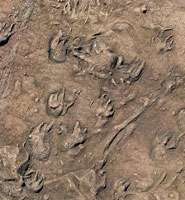Earliest evidence for reptiles

Newly discovered fossilised footprints provide the earliest evidence yet for the evolution of reptiles – a major event in the history of life. They are 315 million years old, making reptiles up to 3 million years older than previously thought.
The footprints were discovered by Dr Howard Falcon-Lang from the University of Bristol in sea cliffs, New Brunswick, Canada. The results of his study, undertaken with UK and Canadian colleagues, are published today in the Journal of the Geological Society of London.
Until now, the oldest reptile fossils were skeletons found in 1859 by William Dawson in Nova Scotia, and named Hylonomus lyelli after the nineteenth century geologist, Sir Charles Lyell.
Falcon-Lang said, “The new fossils were found in the same general region but at a level in the rock strata almost a kilometer below Dawson’s discovery. Consequently we can be confident the footprints are older than the skeletons. They were preserved when reptiles walked across the muddy bottom of a dry riverbed.
“The discovery was pure luck. As I walked along remote sea-cliffs at the end of a long day in the field, I passed a recent rock fall. One large slab of rock was covered with hundreds of fossil footprints! The sun was low in the sky and I probably wouldn’t have seen them if it hadn’t been for the shadows.”
Unlike their amphibian cousins, reptiles do not need to return to water to breed so they paved the way for the widespread colonization of dry land, and the establishment of diverse land-based ecosystems today. The difficult part of the study was proving that the footprints were actually those of reptiles and not just primitive amphibians.
“It was a bit like a crime scene investigation,” said Falcon-Lang, “we had found the footprints but who had made them?”
Professor Mike Benton, also of the University of Bristol, who co-authored the study, added, “There were only a few species capable of making prints like this around at the time so we came up with a short-list of suspects. However, the prints showed that the hands had five fingers and scales, sure evidence they were made by reptiles and not amphibians”.
The footprints prove that reptiles evolved even earlier than previously thought and existed in seasonally dry river-plains, a bit like those of northern Australia today. As the first pioneers of dry continental environments, they paved the way for the diverse terrestrial ecosystems that exist today.
Source: University of Bristol





















